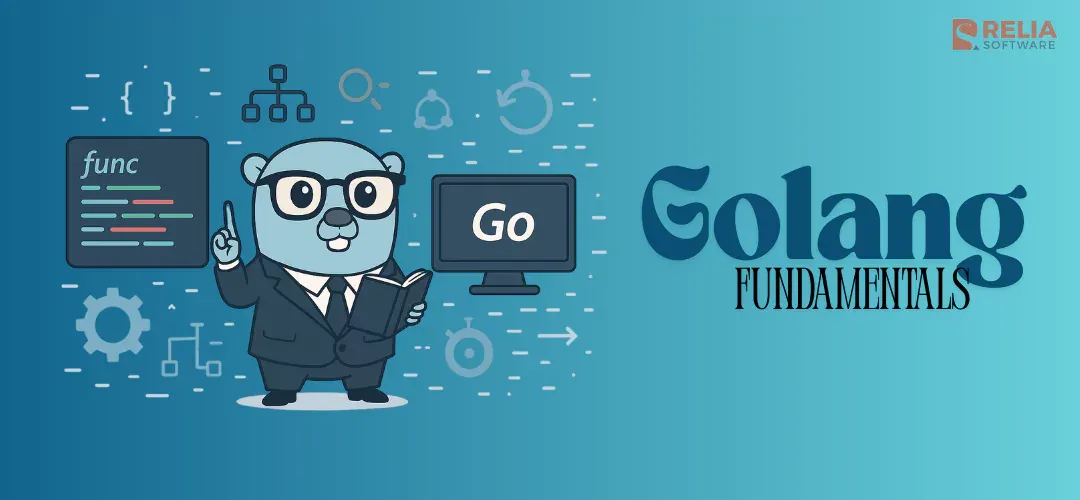This Go tutorial is intended for software developers who are in need of a fundamental understanding of the Go programming language. This guide will provide you with a solid foundation in Golang basics, enabling you to easily progress to more advanced levels.
>> Read more:
- Top 10 Best Golang Web Frameworks
- Top 10 Best IDEs for Golang Web Development
Overview of The Go Programming Language in Current Market
In the evolving landscape of programming languages, Golang, or Go, stands out as a unique and powerful tool. Developed in an open-source project by a team at Google, including Robert Griesemer, Rob Pike, and Ken Thompson, Go was officially launched in 2009. It quickly gained attention for its simplicity, efficiency, and handling of concurrency.
Designed to address the shortcomings of other programming languages while maintaining their advantageous features, Go is a statically typed language with syntax loosely derived from C. It offers the speed of a compiled language with the convenience of garbage collection and dynamic typing.
This blog aims to uncover the basics of Go, making it accessible to beginners and providing a foundation upon which to build further knowledge. This guide will navigate you through the core concepts of Golang, its environment setup, syntax, and its approach to concurrency, all with practical examples and insights.
Let's uncover the capabilities and features that make Golang a top choice for developers in various domains, from cloud services to network programming.
Why Choose Golang?
In the diverse ecosystem of programming languages, Golang, or Go, distinguishes itself through a combination of simplicity, efficiency, and concurrency support. Its design, inspired by the need for high-performance systems, offers a streamlined approach to software development.
The simplicity of Go lies in its clean syntax and readability, reducing the cognitive load on developers and allowing them to focus on solving complex problems rather than grappling with the language itself.
This simplicity does not compromise its power; Go is incredibly efficient, with performance comparable to C or C++. This efficiency is particularly valuable in building high-speed and resource-efficient applications.
Go's real strength, however, shines in its approach to concurrency. With features like goroutines and channels, Go enables the development of concurrent processes in a more straightforward and manageable way compared to other languages. This makes it an excellent choice for modern computing needs where handling numerous tasks simultaneously is a common requirement.
These attributes of Go have made it a popular choice in several fields. In cloud computing, Go's efficiency and ability to handle large-scale network operations make it ideal for developing cloud infrastructure and services.
Its robustness and simplicity also make it well-suited for developing microservices – small, independently deployable services that make up a larger application. By leveraging Go, developers can build reliable, scalable, and maintainable microservices.
>> You may consider:
- Detailed Code Examples of Dependency Inversion in Golang
- Best Practices For Dependency Inversion in Golang
- Hands-On Implementation for Dependency Injection in Go
Go Syntax and Basics
Simplicity and Readability of Syntax
Go's syntax is known for its minimalism and clarity. Unlike many other languages, Go does not require semicolons at the end of every statement if it is followed by a newline, making the code more readable. For example:
package main
import "fmt"
func main() {
fmt.Println("Hello, World!")
}Variables and Type Inference
Variables in Go can be explicitly typed, but Go also offers type inference using the := syntax. Here's an example of both:
var explicitInt int = 10 // Explicit type declaration
implicitInt := 20 // Type inference
fmt.Println(explicitInt, implicitInt)Data Types
Go supports basic data types like integers, floats, booleans, and strings. Here's an example with different data types:
var (
name string = "Golang"
age int = 10
rate float64 = 3.14
)
fmt.Println(name, age, rate)Control Structures
Go simplifies loops with the for keyword and conditional execution with if-else statements. Here are examples of each:
- For Loop:
for i := 0; i < 5; i++ {
fmt.Println(i)
}- If - Else Statement:
if age > 18 {
fmt.Println("Adult")
} else {
fmt.Println("Minor")
}Functions and Error Handling
Functions in Go can return multiple values, which is especially useful for error handling. Here's a simple function example:
func divide(a, b float64) (float64, error) {
if b == 0.0 {
return 0.0, errors.New("division by zero")
}
return a / b, nil
}
result, err := divide(10.0, 2.0)
if err != nil {
fmt.Println("Error:", err)
} else {
fmt.Println("Result:", result)
}Understanding Golang Concurrency
One of Go's most powerful features is its native support for concurrency, the ability of the program to handle multiple tasks at once. Go approaches concurrency with a unique and straightforward model, centered around goroutines and channels.
Goroutines
Goroutines are lightweight threads managed by the Go runtime. They are simple to create and use less memory than traditional threads, enabling the efficient handling of thousands of concurrent tasks. You start a goroutine simply by prefixing a function call with the go keyword. For example:
func printNumbers() {
for i := 1; i <= 5; i++ {
fmt.Println(i)
}
}
func main() {
go printNumbers() // This starts the printNumbers function as a goroutine
fmt.Println("Started goroutine")
time.Sleep(1 * time.Second) // Wait for the goroutine to finish
fmt.Println("Main function finished")
}Channels
Channels are Go's way of enabling communication between goroutines. They allow you to send and receive values between goroutines, ensuring that data is safely exchanged. Here's a basic example:
func main() {
messages := make(chan string)
go func() {
messages <- "Hello, Go Concurrency!"
}()
msg := <-messages
fmt.Println(msg)
}In this example, a goroutine sends a string to the messages channel, which is then received by the main function. This pattern of communication is key to writing concurrent programs in Go, allowing for easy and safe data exchange between multiple goroutines.
Through goroutines and channels, Go provides a robust and efficient way to handle concurrency, making it ideal for applications that require high performance and scalability.
>> You may be interested in: Comprehending Arrays and Slices in Go Programming Language
Conclusion
In this blog, we've explored the fundamental aspects of Golang, highlighting its simplicity, efficiency, and unique approach to concurrency with goroutines and channels. From its readable syntax and robust error handling to its powerful concurrency model, Go offers a compelling toolkit for modern programmers.
As you continue your journey with Go as a competent Golang developer, we encourage you to delve deeper into its advanced features and rich ecosystem. The road to mastering Go is filled with exciting opportunities for growth and innovation. Embrace the learning curve, engage with the community, and discover the myriad of ways Go can enhance your programming repertoire.
>>> Follow and Contact Relia Software for more information!
- coding
- development
- golang

